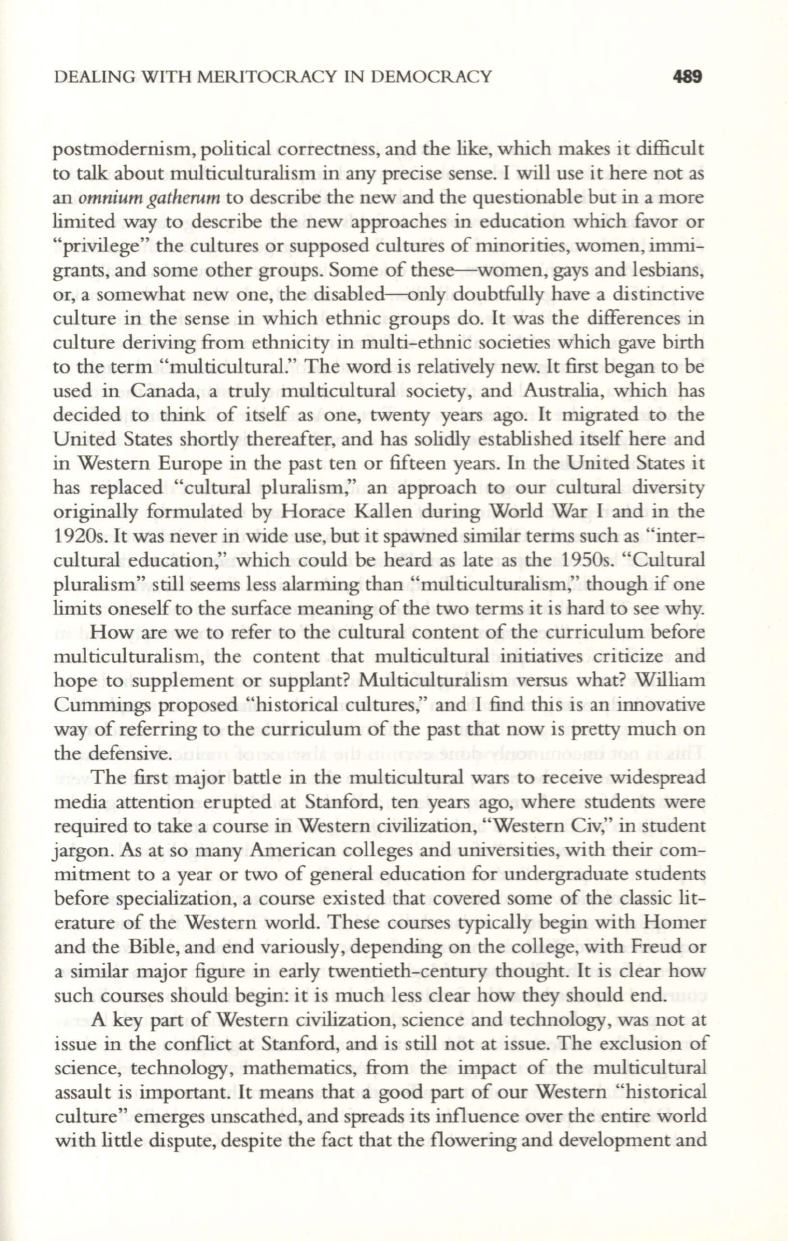
DEALING WITH MERITOCRACY IN DEMOCRACY
489
postmodernism, political correctness, and the like, which makes it difficult
to
talk
about multiculturalism in any precise sense. I will use it here not as
an
omnium gatherum
to describe the new and the questionable but in a more
limited way to describe the new approaches in education which favor or
"privilege" the cultures or supposed cultures of minorities, women, immi–
grants, and some other groups. Some of these--women, gays and lesbians,
or, a somewhat new one, the disabled-only doubtfully have a distinctive
culture in the sense in which ethnic groups do.
It
was the differences in
culture deriving from ethnicity in multi-ethnic societies which gave birth
to the term "multicultural." The word is relatively new.
It
first began to be
used in Canada, a truly multicultural society, and Australia, which has
decided to think of itself as one, twenty years ago.
It
migrated to the
United States shortly thereafter, and has solidly established itself here and
in Western Europe in the past ten or fifteen years.
In
the United States it
has replaced "cultural pluralism," an approach to our cultural diversity
originally formulated by Horace Kallen during World War I and in the
1920s.
It
was never in wide use, but it spawned similar terms such as "inter–
cultural education," which could be heard as late as the 1950s. "Cultural
pluralism" still seems less alarming than "multiculturalism," though
if
one
limits oneself to the surface meaning of the two terms it is hard to see why.
How are we to refer to the cultural content of the curriculum before
multiculturalism, the content that multicultural initiatives criticize and
hope to supplement or supplant? Multiculturalism versus what? William
Cummings proposed "historical cultures," and I find this is an innovative
way of referring to the curriculum of the past that now is pretty much on
the defensive.
The first major batde in the multicultural wars to receive widespread
media attention erupted at Stanford, ten years ago, where students were
required to take a course in Western civilization, "Western Civ," in student
jargon.
As
at so many American colleges and universities, with their com–
mitment to a year or two of general education for undergraduate students
before specialization, a course existed that covered some of the classic lit–
erature of the Western world. These courses typically begin with Homer
and the Bible, and end variously, depending on the college, with Freud or
a similar major figure in early twentieth-century thought.
It
is clear how
such courses should begin: it is much less clear how they should end.
A key part of Western civilization, science and technology, was not at
issue in the conflict at Stanford, and is still not at issue. The exclusion of
science, technology, mathematics, from the impact of the multicultural
assault is important.
It
means that a good part of our Western "historical
culture" emerges unscathed, and spreads its influence over the entire world
with litde dispute, despite the fact that the flowering and development and


